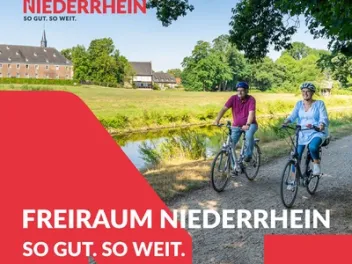Typical
Lower Rhine
Straight ahead until just before the Netherlands. This is how you can roughly describe the location of the Lower Rhine region in the very west of Germany.
The Lower Rhine: it's not just the location that's impressive here, but also the dreamlike landscape: gnarled willow trees, straight poplar avenues, sunny yellow rape fields, alluvial landscapes and old Rhine arms, romantic lakes and heath moors, orchards and fields characterise the landscape and entice you to enjoy a varied nature experience. Whether you are travelling on foot, by bike or on the water, the Lower Rhine landscape is always impressive.
Steeped in history
Hardly any other German landscape can point to such a long history as the Lower Rhine region, which has been demonstrably populated since prehistoric times and flourished under Roman rule. However, the name not only refers to the lower reaches of the Rhine, it also stands for the land on both sides of the river.
Core Area
The region stretches in the far west of North Rhine-Westphalia between the Rhine and the Netherlands. The core area of the Lower Rhine includes the districts of Kleve, Wesel and Viersen as well as the cities of Krefeld and Duisburg. The Lower Rhine also includes parts of the towns of Isselburg and Oberhausen, the Rhine district of Neuss, the city of Mönchengladbach and the district of Heinsberg on its eastern and southern edges. More than 2 million inhabitants live in this area, which has no traditional borders.
Wesel is located in the "Lower Lower Rhine" region, which stretches from Duisburg along the Rhine through the districts of Wesel and Kleve to the Dutch border.





